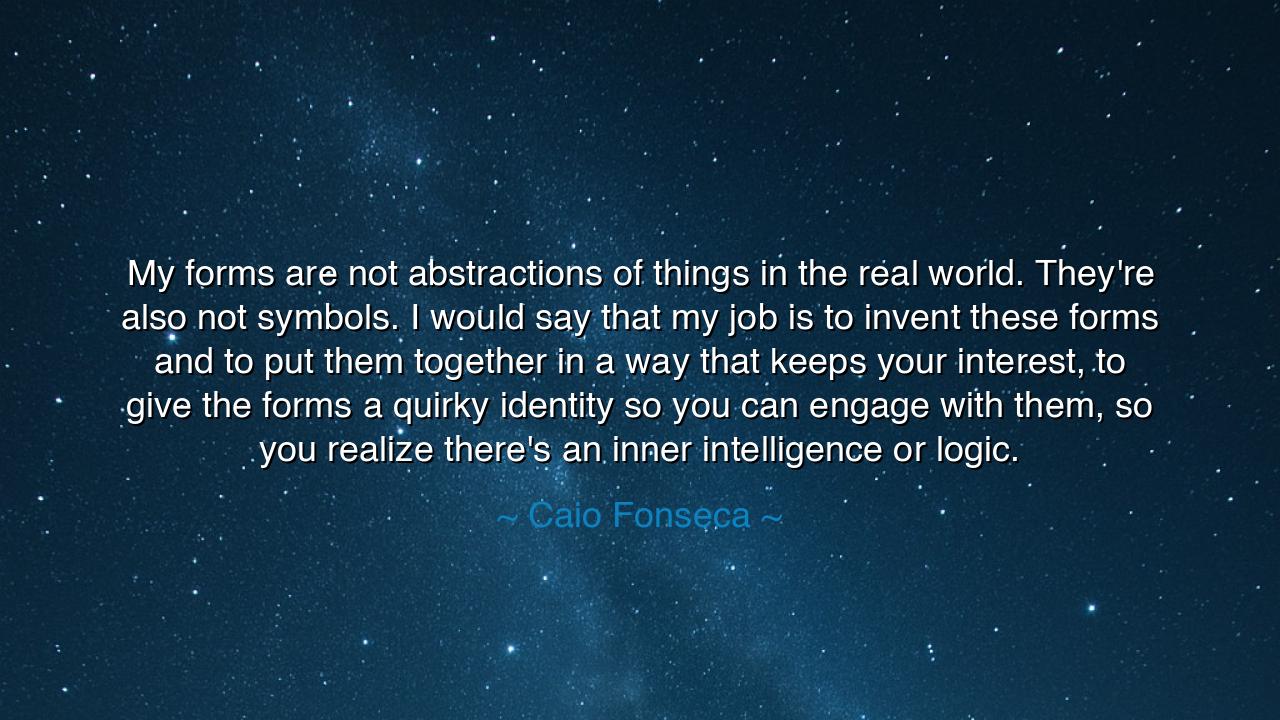
My forms are not abstractions of things in the real world.
My forms are not abstractions of things in the real world. They're also not symbols. I would say that my job is to invent these forms and to put them together in a way that keeps your interest, to give the forms a quirky identity so you can engage with them, so you realize there's an inner intelligence or logic.






The words of Caio Fonseca, painter and seeker of form, speak like the voice of an ancient craftsman who molds the invisible into being: “My forms are not abstractions of things in the real world. They're also not symbols. I would say that my job is to invent these forms and to put them together in a way that keeps your interest, to give the forms a quirky identity so you can engage with them, so you realize there's an inner intelligence or logic.” Within these words lies the quiet philosophy of creation itself — the sacred act of invention, of giving birth to something that has never before existed, and breathing into it the spark of intelligence that makes it alive in the soul of the beholder. Fonseca’s art is not imitation, nor allegory; it is the summoning of essence, the weaving of thought into form until even the silent line seems to think.
From the dawn of civilization, artists have stood between the worlds — between the seen and the unseen, between the real and the imagined. The ancients of Greece carved their gods not as copies of men, but as embodiments of ideas — beauty, strength, wisdom, justice. Yet Fonseca departs from both imitation and symbol, declaring that his forms are their own reality. They are not reflections, but inventions — each possessing its own rhythm, its own pulse, its own hidden reason. Just as the philosopher seeks truth in words, the artist seeks truth in shapes, colors, and space. For him, art is not the mirror of nature, but the mirror of mind.
This is the lineage of all true creators — those who, like Leonardo da Vinci, looked upon the chaos of existence and saw geometry and motion, pattern and possibility. Leonardo’s sketches of flying machines and whirling waters were not abstractions; they were conversations with the hidden logic of nature, with the invisible intelligence that moves all things. Fonseca’s words echo that same calling: to find the inner logic within form, to create not from imitation but from discovery — to coax order and meaning out of emptiness.
There is a profound humility in Fonseca’s declaration that his “job” is to invent forms and keep the viewer’s interest. It reminds us that art is not for the artist alone, but for the communion between creator and witness. The quirky identity of his forms — their individuality, their playfulness — becomes a bridge between souls. When we look upon such art, we are not asked to understand in the ordinary sense; we are asked to engage, to feel that the work is alive with purpose. It whispers, “There is thought here, and you are invited to think with me.”
Consider, too, how this mirrors the making of life itself. The universe, vast and formless, once was chaos — until through time, pattern emerged. Stars aligned, rivers formed, and from dust rose consciousness. Fonseca, like the ancient mythic creators, performs this cosmic act in miniature. He takes the formless — a blank canvas — and breathes into it an intelligence that did not exist before. In this sense, he is not just a painter, but a maker of worlds, each one small, peculiar, and complete unto itself.
The lesson, then, is not only for the artist but for all who create, who live, who think. In everything you do — whether it is painting, writing, speaking, or simply being — strive not merely to copy what already exists, nor to cloak your work in empty symbols. Instead, invent. Let your creation bear the stamp of your own logic, your own inner order. Let it reflect the uniqueness of your spirit, that others may look upon it and sense the presence of something alive and thinking. To create is not to reproduce the world, but to reimagine it.
And finally, remember this: the world hungers not for perfection, but for authenticity. Be unafraid of giving your work — and your life — a quirky identity, as Fonseca says. For it is through such individuality that others will feel your truth. The ancient sculptor’s chisel, the poet’s pen, the musician’s bow — all are guided by one hand, the eternal intelligence within form. Seek that intelligence in all you make. Bring forth shapes that think, sounds that feel, actions that breathe. In doing so, you will join the oldest lineage of humankind — not imitators of the world, but co-creators of its soul.






AAdministratorAdministrator
Welcome, honored guests. Please leave a comment, we will respond soon